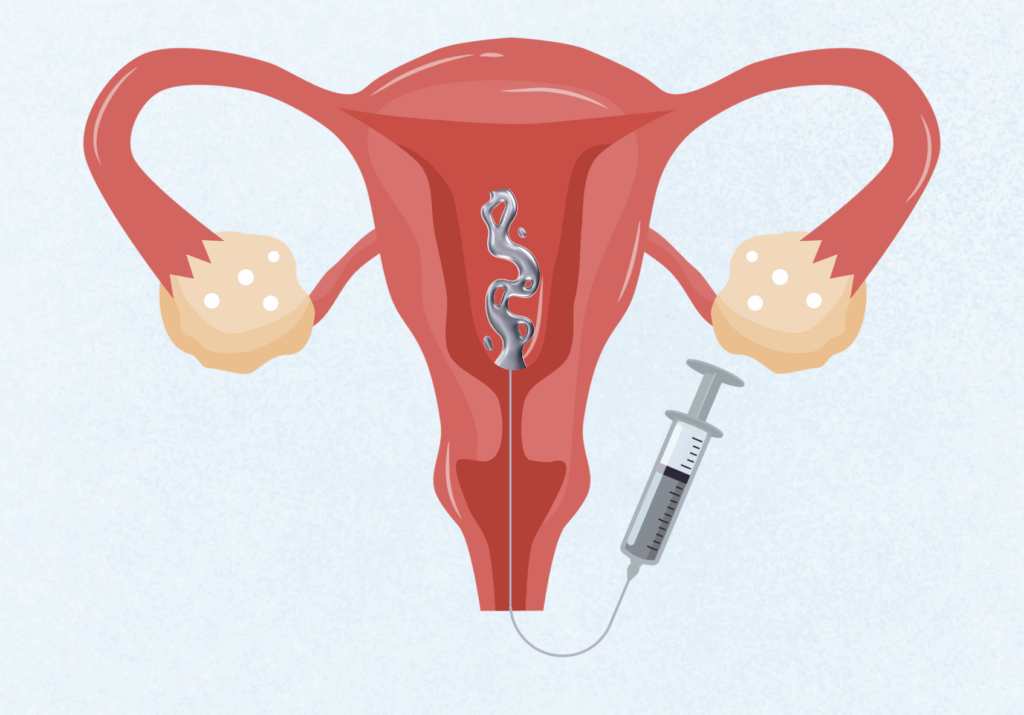Hysterosalpingogram (HSG)
What is an HSG?
An HSG, or hysterosalpingogram, is an X-ray test used in fertility care to check the uterus and fallopian tubes using a special dye. HSGs are usually done when someone has been trying to get pregnant without success and are typically recommend for timed intercourse and IUI cycles.

An HSG can give doctors information about:
– Whether the fallopian tubes are blocked
– The shape and size of the uterus
– Uterine abnormalities
In some cases per the radiologist, HSGs can also help clear minor blockages in the tubes, which may slightly increase chances of pregnancy afterward.
About the HSG Test
In this procedure, a catheter will be placed inside the cervix using vaginal ultrasound to guide it. The doctor will then slowly inject a dye into the uterus. The dye will show up on an x-ray, so the radiologist will be able to visualize how the dye travels. It is usually not performed under anesthesia and is relatively quick.
HSGs are typically done between days 5 and 10 of a cycle and takes place at a radiology center outside of Generation Next Fertility.

Hysterosalpingogram (HSG) FAQs:
Does an HSG Hurt?
Most patients feel mild to moderate cramping, similar to menstrual cramps, during the dye injection. The discomfort is usually brief and goes away once the test is finished.
What can I take to help with pain from my HSG?
You may take Motrin (ibuprofen) or any pain medication recommended by the radiologist prior to your HSG.
How long does the test take?
The procedure itself usually takes less than 15 minutes.
When in my cycle is the test done?
HSG is typically scheduled between cycle days 5 and 10, after bleeding has stopped but before ovulation.
Do I need anesthesia?
HSG is usually performed without anesthesia. Some patients take an over-the-counter pain reliever (like ibuprofen) beforehand to ease cramping.
Can I go back to work afterward?
Yes, most patients return to normal activities the same day. You may have light spotting or mild cramping for a few hours afterward.
Are there any risks?
Complications are rare, but possible risks include infection, allergic reaction to the dye, or light bleeding. Your doctor will review your medical history to minimize these risks.
Meet the Minds Shaping the Future of Fertility Care
At Generation Next Fertility, our physicians bring together decades of experience in reproductive medicine with a shared belief that care should feel as precise as it is personal. Our providers approach each patient as an individual: integrating science, intuition, and communication to build trust through understanding. Their expertise spans every stage of fertility care to meet you where you are and guide you forward with clarity and confidence.
“We’re a very different kind of fertility center offering a next-generation level of care blended with world-class science. That attentiveness is what makes our patients feel truly seen.”
“Ever since I was a little girl, I have wanted to empower and educate women so that they can have full control of their journey to parenthood. It’s the most fulfilling aspect of my career.”
“Every day I see hopeful parents who have been turned away from clinics that fall outside their standard protocols. Great treatment does not have to come at the cost of being treated like a number.”
“From a young age, I knew that my purpose was to make a difference in women’s health, rooted in my upbringing within the medical industry and my personal connection to endometriosis.”




